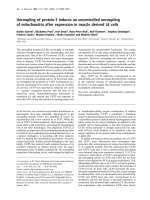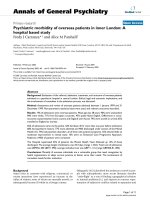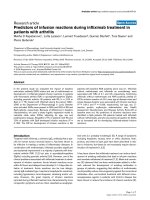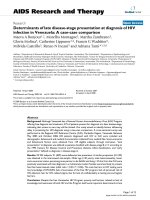Báo cáo y học: "Determinants of improvement in quality of life of alcohol-dependent patients during an inpatient withdrawal programme"
Bạn đang xem bản rút gọn của tài liệu. Xem và tải ngay bản đầy đủ của tài liệu tại đây (219.31 KB, 8 trang )
Int. J. Med. Sci. 2009, 6
160
I
I
n
n
t
t
e
e
r
r
n
n
a
a
t
t
i
i
o
o
n
n
a
a
l
l
J
J
o
o
u
u
r
r
n
n
a
a
l
l
o
o
f
f
M
M
e
e
d
d
i
i
c
c
a
a
l
l
S
S
c
c
i
i
e
e
n
n
c
c
e
e
s
s
2009; 6(4):160-167
© Ivyspring International Publisher. All rights reserved
Research Paper
Determinants of improvement in quality of life of alcohol-dependent pa-
tients during an inpatient withdrawal programme
Pierre Lahmek, Ivan Berlin, Laurent Michel, Chafia Berghout, Nadine Meunier, Henri-Jean Aubin
Centre de Traitement des Addictions, Hôpital Emile Roux, Assistance Publique-Hôpitaux de Paris, 94450 Limeil-Brévannes,
France
Correspondence to: Henri-Jean Aubin, Centre d’Enseignement, de Recherche et de Traitement des Addictions, Hôpital
Paul Brousse, Assistance Publique-Hôpitaux de Paris, 94804 Villejuif, France.
Received: 2009.03.04; Accepted: 2009.05.15; Published: 2009.05.18
Abstract
Background: To investigate the improvement in quality of life (QoL) of alcohol-dependent
patients during a 3-week inpatient withdrawal programme, and to identify the sociodemo-
graphic, clinical and alcohol-related variables associated with baseline QoL on admission and
with improvement of QoL during residential treatment.
Methods: This prospective, observational study included 414 alcohol-dependent patients,
hospitalised for a period of 3 weeks. QoL was measured on admission and at discharge using
the French version of the Medical Outcome Study SF-36. The mean scores for each dimen-
sion and for the Physical and Mental Component Summary scores were calculated.
Results: The mean scores per dimension and the mean Physical and Mental Component
Summary scores were significantly lower on admission than at discharge; the lowest scores
being observed for social functioning and role limitations due to emotional problems. At
discharge, the mean scores per dimension were similar to those observed in the French
general population. Female gender, age >45 years, living alone, working as a labourer or
employee, somatic comorbidity, and the existence of at least five criteria for alcohol de-
pendence according to the DSM-IV classification were associated with a low Physical Com-
ponent Summary score on admission; psychiatric comorbidity, the presence of at least five
DSM-IV dependence criteria, smoking and suicidality were associated with a low Mental
Component Summary score on admission. The increase in Physical and Mental Component
Summary scores during hospitalisation was more marked when the initial scores were low.
Apart from the initial score, the greatest improvement in Physical Component Summary
score was seen in patients with a high alcohol intake and in those without a somatic co-
morbidity; the increase in Mental Component Summary score was greatest in patients
without psychotic symptoms and in those who abused or were dependent on illegal drugs.
Conclusion: QoL improvement after a residential treatment was related to low QoL
scores at admission. Improvement in physical component of QoL was related to baseline
alcohol intake and good somatic status. Improvement in mental component of QoL was re-
lated to other drugs abuse/dependence.
Key words: alcohol-dependent patients, residential treatment, quality of life
Introduction
Alcohol dependence is a chronic disorder. If a
complete cure of the disorder is generally not possi-
ble, long-term supervision of alcohol dependence is
required in order to ensure that alcohol-dependent
Int. J. Med. Sci. 2009, 6
161
patients have the best possible state of general health.
The World Health Organisation (1) has defined health
not only as the absence of disease but also as a state of
physical, mental and social well-being. The idea of
quality of life (QoL) incorporates these dimensions
and can be defined as “an individual’s perception of
their position in life, and in the context of the culture
and value systems in which they live, and in relation
to their goals, expectations, standards and concerns
(1).
The alcohol use disorder, which is usually
chronic, requires patients to muster all their capacities
for reconstruction and adaptation. QoL, which is a
concept situated between social and clinical sciences,
is a pertinent indicator to evaluate the subjective ex-
perience of the patient and to quantify the psychoso-
cial burden of alcoholism (2, 3). Measurement of a
patient’s QoL requires a different approach to that
typically used in clinical research, where the phycian
is generally responsible for rating the health condition
of the patients. In quality of life research the aim is to
measure the patients’ subjective perception of their
state of health and life using a standardised ques-
tionnaire. Subjective perceptions of the patient may
indeed by quite different from the clinician’s percep-
tion of the health status of the patient (4, 5). Pa-
tient-reported outcome measures such as QoL may be
useful in orientating choice between different thera-
peutic options since effective treatment should not
only improve the clinical state and prognosis of the
patient but also their QoL. The initial QoL of patients
can also affect the prognosis of various disease states
(3).
In alcohol-dependent patients, most published
reports have investigated the effects of alcohol inter-
vention strategies on objective clinical or psychologi-
cal criteria such as alcohol intake, biological variables,
severity of dependence, motivation for change, so-
matic or psychiatric comorbidities (6, 7). However,
this approach is sometimes too limited because it does
not capture adequately information on how a patient
adapts to treatment and lifestyle changes (8). In cur-
rent practice standards, the QoL of alcohol-dependent
patients is not measured systematically, even though
this is relevant to the psychosocial context of the in-
terventions and to describing how actively patients
will participate in their own care (9-11). Studies
dedicated to the analysis of QoL of alcohol-dependent
patients have already yielded valuable information,
whether measuring basal QoL, its improvement dur-
ing patient care, or its influence on alco-
hol-dependence itself (9-20). Most of these studies
have found QoL to be decreased considerably in al-
cohol-dependent patients, but little information is
available on how QoL changes during a therapeutic
intervention (9-13, 19, 21). Some studies have identi-
fied factors associated with a poor QoL at the begin-
ning of treatment in alcohol-dependent patients but
these have not been investigated in a systematic way
predictors of change in QoL (13, 20). The variables
associated with an improvement in QoL of patients
during care and the influence of QoL on the prognosis
of alcoholism are unknown (22, 23).
The aims of this study in a clinical setting was: 1)
to determine the change in QoL of alcohol-dependent
patients during a 3-week inpatient programme; 2) to
identify the variables associated with QoL in alco-
hol-dependent patients before detoxification, and
how they change during a 3-week inpatient pro-
gramme.
Materials and methods
Population studied
The study was carried out in the Addiction
Treatment Centre, Hôpital Emile Roux,
Limeil-Brévannes, Paris. The study population con-
sisted of all alcohol-dependent patients (n=414), as
defined by DSM-IV criteria, who were hospitalised for
a period of 3 weeks over a 30-month inclusion period.
Patients who could not understand or read the ques-
tionnaires for intellectual or social-educational rea-
sons were not included. Briefly, the inpatient thera-
peutic program consisted in a benzodiazepine treat-
ment adapted to each patient alcohol withdrawal
syndrome, a medical treatment of any psychiatric and
somatic comorbidities, and a standardized psychoso-
cial treatment.
Measures
In the therapeutic programme offered by the
study centre, structured diagnostic interviews and
questionnaires were administered routinely for
evaluation of all patients.
The variables evaluated included the following:
sociodemographic variables (age, gender, ethnic origin,
family structure, level of education, socioprofessional
group, professional activity); alcohol-related variables
(alcohol consumption and number of days of absti-
nence during the 6 months preceding hospitalisation,
duration of alcohol dependence, length of time since
the first alcohol-related period of care, family history
of alcoholism in the father or mother); diagnosis of
abuse or dependence on other psychoactive substances,
either legal (sedatives, tobacco), or illegal (opiates,
cannabis, cocaine, amphetamines, solvents, hallu-
cinogens, phencyclidine); somatic comorbidity (alco-
hol-related diseases, HIV, HBV, or HCV positive se-
Int. J. Med. Sci. 2009, 6
162
rologies, weight and height, Charlson index, index of
functional comorbidity, psychiatric comorbidity); al-
cohol-induced or alcohol-independent mood disorders
(major depressive episode, dysthymia, episode of
mania or hypomania), alcohol-induced or
-independent anxiety disorder (panic disorder, gen-
eralized anxiety disorder, social phobia, agoraphobia,
obsessive-compulsive disorder), post-traumatic stress
disorder, psychotic symptoms (checklist); QoL. Sui-
cidality was defined as any suicidal thoughts in the
past month or any lifetime suicide attempt.
Level of education, socioprofessional category,
professional activity and family structure were de-
fined according to the criteria used by the Institut
National de la Statistique et des Etudes Economiques
(INSEE), France. Alcohol consumption was assessed
using a standardised questionnaire, the existence of
an alcohol problem in the patient’s father or mother
was investigated using the F-SMAST and M-SMAST
questionnaires, respectively (24). Diagnosis of abuse
or dependence on alcohol or other psychoactive sub-
stances was performed using the DSM-IV criteria,
assessed with the Mini-International Neuropsychiat-
ric Interview (MINI) (25). This is a structured inter-
view that enables any lifetime Axis 1 diagnosis of the
DSM-IV. Dependence was defined by the presence of
at least three of the seven diagnostic criteria. The se-
verity of alcohol dependence was considered to be
proportional to the number of DSM-IV criteria for
dependence.
All somatic comorbidities were identified during
the interview, irrespective of whether they were his-
torical conditions that had resolved with or without
sequalae, or current conditions that had developed
progressively over the patient’s lifetime. The Charl-
son’s index was used to identify serious somatic co-
morbidities and assess their severity (26). Groll’s in-
dex of functional comorbidity was used to reveal any
chronic and/or disabling pathology (27). The pres-
ence of a somatic disease related to excessive alcohol
consumption was specified. Weight and height were
measured systematically during clinical examination
and body mass index (BMI) was calculated.
Diagnosis of DSM-IV psychiatric comorbidities
over the patients’ lifetime was carried out using the
MINI. For some diagnoses, disorders independent
from or induced by alcohol-dependence were identi-
fied. Disorders were considered to be alco-
hol-independent if they had appeared before the al-
cohol abuse or dependence onset or after a period of
abstinence of at least 1 month. Otherwise the problem
was considered to have been alcohol-induced.
The QoL of patients was measured using the
MOS SF-36. This questionnaire was administered to
all patients on admission and at discharge; the mean
time interval between the two was 19 ± 8 days.
The MOS SF-36 is the short form of a 149-item
questionnaire developed during an observational
study to assess the state of health of 2546 patients with
chronic cardiovascular disease or diabetes,
the Medical Outcome Study (MOS), carried out be-
tween 1986 and 1990 (28). The SF-36 is a
self-administered generic health-related QoL profile
which includes 36 items distributed across eight di-
mensions: 1) physical functioning (29); 2) role limita-
tions attributable to physical problems (RP); 3) bodily
pain (BP); 4) perception of general health (GH); 5)
vitality (VI); 6) social functioning (SF); 7) role limita-
tions attributable to emotional problems (RE) and 8)
mental health (MH). Dimension scores are normalised
in order to obtain a value between 0 and 100 inclusive
(100*(score obtained – minimum score possi-
ble)/(maximum score possible – minimum score pos-
sible)), a high score indicating a good QoL (30). Two
aggregate scores can be calculated from the scores for
the eight dimensions, the Physical Component Sum-
mary score and the Mental Component Summary
score. These two scores are also standardised by
weighting the eight individual dimension scores us-
ing coefficients derived from studies carried out in the
US general population (31). The upper and lower
limits of these scores are 8 and 73 for the Physical
Component Summary, and 10 and 74 for the Mental
Component Summary (31). The SF-36 has been trans-
lated and validated in many different languages, in-
cluding French. Standardised normative reference
scores have been determined from studies in the
French general population, allowing comparisons to
be made between populations of different origins or
different sociocultural backgrounds (30, 32). The
SF-36 has also been used and validated in alco-
hol-dependent patients (13, 19).
Statistical analysis
QoL scores on admission and at discharge were
compared using the Wilcoxon test. The Physical and
Mental Component Summary scores were calculated
for each patient on admission. Patients were catego-
rised into three subgroups of equal size according to
the value obtained for each Summary scores. The dif-
ferences between the Physical and Mental Component
Summary scores at discharge and on admission were
calculated in order to determine the improvement in
QoL of patients during the inpatient programme.
Again, patients were categorised into three subgroups
of equal size according to the degree of improvement
observed.
Int. J. Med. Sci. 2009, 6
163
Univariate analyses were carried out by com-
paring patients as a function of their QoL (QoL on
admission, or difference in QoL between admission
and discharge). Patients with poor QoL (i.e. lowest
tercentile) on admission were compared with the
other patients in terms of baseline variables using
univariate analysis. Baseline variables were dichoto-
mized choosing the median value as a cut off. A
similar approach was used to compare patients with a
large (i.e. combination of middle and higher tercen-
tiles) vs low improvement in QoL. Quantitative vari-
ables were compared by ANOVA and frequencies
were compared using the Chi-square test. Normally
distributed quantitative variables are expressed as
means ± SEM. Non-normally distributed variables
were expressed as median and range. Multivariate
logistic regression analyses were used to test the in-
dependent contribution of variables to QoL after ad-
justment for confounding factors. Independent vari-
ables were included in the logistic regression if their
distribution between QoL categories differed at a
probability level of p≤0.05 in univariate analyses. A
probability threshold of ≤0.05 was considered to be
statistically significant. All statistical tests were car-
ried out using the statistical software package SPSS
11.0 (SPSS Inc. Chicago IL).
Results
Characteristics of the study population
The characteristics of the 414 patients are shown
in Table 1. Two hundred seventy eight men and 136
women were included, 116 (25%) patients had a his-
tory of abuse or dependence on illegal drugs or seda-
tives at sometime in their life, 34 (8%) patients were
seropositive for hepatitis C, 28 (7%) were chronic car-
riers of the HBs antigen, seven patients (2%) were HIV
serology positive, and 286 (69%) presented at least one
chronic somatic disorder according to the classifica-
tion of Groll. One-hundred and sixty-seven (40%)
patients presented a serious comorbid disease, i.e. a
score of 1 to 5 according to the classification of
Charlson and 85 (21%) presented an alcohol-related
disease, in particular liver cirrhosis which was diag-
nosed in 33 (8%) patients. A lifetime psychiatric co-
morbidity was diagnosed in 325 (79%) patients; anxi-
ety (independent or alcohol-induced) was the most
frequent psychiatric comorbidity, diagnosed in 305
(74%) patients.
Table 1: Characteristics of the study population (n=414).
Variable Number (%)
Age* 43 ± 10
Sex ratio (male/female) 2.04
European ethnicity 368 (89)
Living alone 159 (39)
Post-secondary education 149 (38)
Unemployed 239 (58)
Duration of regular alcohol consumption
(years)°
23 [1, 56]
Number of days of abstinence in the previous
6 months°
20 [0, 140]
Alcohol intake (drinks/day)° 16 [0, 60]
Duration of alcohol-dependence (years)° 8 [0, 37]
Alcoholic father or mother 146 (35)
Current smoker 338 (82)
Abuse or dependence on illegal drugs 69 (17)
Abuse or dependence on sedatives 65 (16)
Serious comorbid disease
+
167 (40)
Alcohol-related disease 85 (21)
Major depressive episode 92 (22)
Dysthymia 22 (5)
Hypomania 8 (2)
Mania 15 (4)
Independent mood disorder 116 (28)
Alcohol-induced mood disorder 150 (36)
Panic disorder 42 (10)
Agoraphobia 69 (17)
Social phobia 66 (16)
Obsessional-compulsive disorder 9 (2)
Generalized anxiety disorder 51 (12)
Post-traumatic stress disorder 44 (11)
Independent anxiety disorder 169 (41)
Alcohol-induced anxiety disorder 136 (33)
At least one psychotic symptom 18 (4)
At least one psychiatric disorder 325 (79)
*Mean ± SEM
° Median value [Min,Max]
+ According to the Charlson’s index (26)
Quality of life of patients on admission and at
discharge
Fifty-four patients (13%) left our centre prema-
turely before the end of the inpatient programme thus
their end of treatment SF-36 questionnaire was un-
available. Scores on each of the eight dimensions of
the SF-36 for these patients on admission were not
significantly different compared with those of the
other patients.
The SF-36 scores for the eight dimensions and for
the Physical and Mental Component Summaries were
significantly lower on admission than at discharge.
On admission, the lowest scores were observed for
social functioning and emotional state. At discharge,
the scores for the eight dimensions were similar to
those for the general French population (Figure 1).
Int. J. Med. Sci. 2009, 6
164
Figure 1: Mean normalised scores of SF-36 dimensions for patients at admission and discharge, compared to SF-36 scores
for the general French population. Filled bars: admission; open bars: discharge. *: The SF-36 scores were significantly lower
on admission than at discharge (p < 0,05, Cohen’s d between 0,45 and 1,1).
Predictive factors of quality of life on admission
Two-thirds of patients had a Physical Compo-
nent Summary score of >42 and two-thirds of patients
had a Mental Component Summary score of >25. The
factors associated with a low Physical Component
Summary score (≤42) on admission are shown in Ta-
ble 2. The regression model including eight variables
and explained 18% of the variance in score on admis-
sion (Table 2). The variables associated with a low
Mental Component Summary score (≤25) on admis-
sion are shown in Table 3. The regression model in-
cluding seven variables explained 20% of the total
variance (Table 3).
Predictive factors of improvement in quality of
life during the inpatient programme
Analysis of the distribution of the values for the
differences (discharge – admission) in Physical and
Mental Component Summary scores for the 360 pa-
tients followed up demonstrated an increase in
Physical Component Summary of >6 points in
two-thirds of patients and an increase in Mental
Component Summary score of >8 points in two-thirds
of patients. The variables associated with a large in-
crease (>6) in Physical Component Summary score
between admission and discharge were: a low value
for this score on admission, alcohol intake ≥10
drinks/day, and the absence of somatic comorbidity
(Table 4). The regression model including these five
variables explained 26% of the variance. The variables
associated with a large increase (>18) in Mental
Component Summary score between admission and
discharge were: a low value for Mental Component
Summary score on admission, absence of a psychotic
disorder, and the presence of abuse or dependence on
illegal drugs (Table 5). The explanatory model in-









